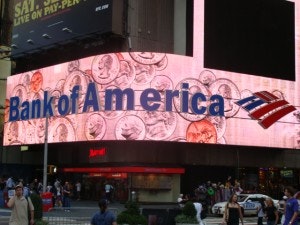
When looking over how some of the top banks trade, one big thing that stood out to me was the relative cheapness of Morgan Stanley (NYSE:MS). It’s been well talked about how cheap Citigroup Inc. (NYSE:C) and Bank of America Corp (NYSE:BAC) are, but shouldn’t Morgan Stanley get some recognition?
Morgan trades with a price-to-book ratio of only about 0.7, while Citi is at 0.7 and Bank of America Corp (NYSE:BAC) at approximately 0.6. Meanwhile, other top investment banks, including Goldman Sachs Group, Inc. (NYSE:GS) and UBS AG (USA) (NYSE:UBS), trade at 0.9 and about 1.2, respectively.
However, after digging a bit deeper, Morgan Stanley’s sub-par valuation may actually be warranted. And it turns out that perhaps Citi and Bank of America Corp (NYSE:BAC) are the ones that are undervalued. With the turmoil over the last five years, Citi is down 81% and Bank of America down 68% over that time period.
Let’s dig a bit deeper
Not only do I not think Morgan Stanley (NYSE:MS) is cheap, but I think Citigroup Inc. (NYSE:C) offers investors an impressive investment opportunity. From a returns standpoint, Citi appears to be head and shoulders above Morgan Stanley.
| Morgan Stanley | Citi | Goldman Sachs | Bank of America | |
| Return on investment | 0.3% | 1.2% | 1.4% | 0.6% |
| Return on equity | 1.8% | 4.6% | 10.7% | 2.1% |
| Return on assets | 0.1% | 0.5% | 0.8% | 0.2% |
Citigroup Inc. (NYSE:C) also happens to have a solid balance sheet, with a debt-to-capital ratio of 55%, compared to Morgan Stanley (70%), Goldman (68%), UBS (84%) and Bank of America (70%).
Over the last few quarters, Morgan Stanley has been taking initiatives to restructure its operations in order to lower balance-sheet risk and focus on less capital-intense businesses, such as global wealth management. However, the firm still struggles with generating meaningful results for shareholders. Part of the issue is its elevated cost structure.
Operating expenses for 2012 only decreased 2% from 2011. As part of the variant view, Morgan was up more than 5% in recent sessions thanks to an upgrade by SunTrust. The bank moved its rating on Morgan from a “neutral” to a “buy” with a $25 price target, which suggest upside of around 15%.
Banking’s best
Citi cleared the 2013 stress test and also managed to outperform other major banks. Its latest capital plan got the company approved for $1.2 billion worth of share repurchases through the first quarter of 2014. What’s also encouraging is Citi’s diverse business model with a significant portion of the revenue being generated from outside the U.S., operating in over 160 countries.
The company’s long-term goal is to continue shrinking non-core assets and increase its fee-based business. The winding down of Citi Holdings (legacy problem assets) continues to run a positive course, with Citi Holdings’ assets decreasing 31% from the prior-year last quarter and making up only 8% of the bank’s total asset at the end of 2012.
The investment banks
Other notable banks include Goldman Sachs Group, Inc. (NYSE:GS) and UBS. Goldman’s main segment (53% of revenue) consists of its institutional client services, which includes client execution activities related to making markets in credit products, interest rate products, mortgages, currencies and commodities.
Goldman Sachs Group, Inc. (NYSE:GS) has managed to knock earnings out of the park over the last four quarters, beating analysts’ estimates by at least 10% each quarter. However, the one downside for Goldman is its increased exposure in Europe. At the end of 2012, Goldman’s total credit exposure increased to $3.9 billion from $2.9 billion in the prior year, and market exposure increased to $1.3 billion from $585 million in Portugal, Italy, Ireland, Greece and Spain.
UBS AG (USA) (NYSE:UBS) witnessed a big loss related to rouge trading activities, but this hasn’t spooked investors with new money inflows still positive. However, the bank’s assets under management are still well off their 2007 second-quarter peak.
UBS AG (USA) (NYSE:UBS) plans to focus on downsizing and reducing fixed income risk-weighted assets to help improve the bank’s position and return on equity over the long term. If not for its high valuation, this investment bank might actually be worth taking a deeper look at; since 3Q 2011 it has managed to reduce its risk-weighted assets 35%.
Bank of America Corp (NYSE:BAC) has been one of the turnaround banks performing nicely of late, growing earnings robustly year over year for 1Q 2013, thanks in part to a slowdown in the provision for credit losses and reduced operating expenses. Bank of America has been relentlessly trying to realign its balance sheet in accordance with the regulatory changes post the meltdown to remain afloat.
In fact, since 2010, the company has completed the divestiture of more than 20 non-core assets to strengthen its capital position. Then in 2012, the bank divested its 49% stake in Mitsubishi UFJ Merrill Lynch PB Securities Co., its JV with Mitsubishi UFJ Financial Group, Inc.
Bank of America Corp (NYSE:BAC) also managed to grow deposits by 7% in 2012 despite a sluggish economy; however, I still like Citi as the best way to play the turnaround banking industry given its better returns and balance sheet.
Don’t be fooled
It appears that Citi is truly cheap, whereas Morgan Stanley could be a value trap. It also appears that Bank of America Corp (NYSE:BAC) is working on an effective turnaround, with better returns than Morgan and a P/B ratio that’s a 13% discount to Morgan Stanley’s. For investors already owning Morgan Stanley stock, it would be advisable to buy some protection with covered calls (an income-oriented strategy).
The article This Bank Is too Cheap to Ignore, or Is It? originally appeared on Fool.com and is written by Marshall Hargrave.
Copyright © 1995 – 2013 The Motley Fool, LLC. All rights reserved. The Motley Fool has a disclosure policy.